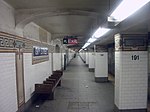Dyckman-Hillside Substation

The Dyckman-Hillside Substation, also known as Substation 17, is a historic electrical substation located at 127-129 Hillside Avenue between Sickles Street and Nagle Avenue, near the Dyckman Street station of the New York City Subway's IRT Broadway–Seventh Avenue Line, in Inwood, Manhattan, New York City. It was one of eight substations constructed by the Interborough Rapid Transit Company in 1904–05. The substation is a two-story, freestanding masonry building in the Beaux-Arts style. It features a hipped roof, tower-like projections, scrolled wrought iron brackets, and terra cotta decorative details.It was listed on the National Register of Historic Places in 2006.
Excerpt from the Wikipedia article Dyckman-Hillside Substation (License: CC BY-SA 3.0, Authors, Images).Dyckman-Hillside Substation
Sickles Street, New York Manhattan
Geographical coordinates (GPS) Address Nearby Places Show on map
Geographical coordinates (GPS)
| Latitude | Longitude |
|---|---|
| N 40.86 ° | E -73.926944444444 ° |
Address
Sickles Street 1
10040 New York, Manhattan
New York, United States
Open on Google Maps









